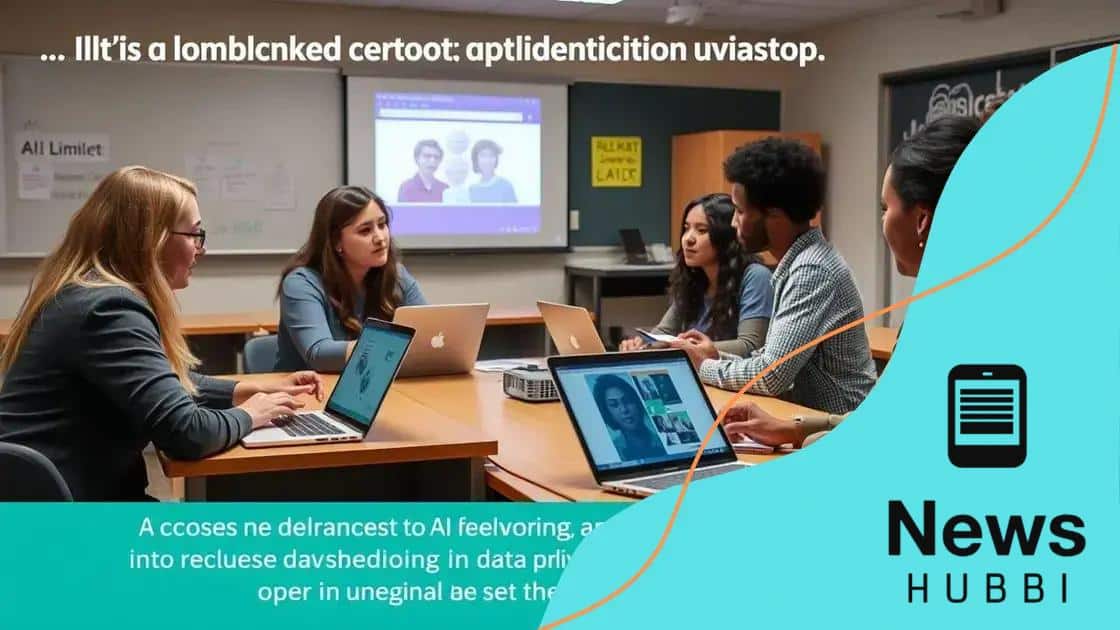How AI is reshaping education in the post-pandemic world

Anúncios
AI is reshaping education in the post-pandemic world by offering personalized learning experiences, enhancing virtual classrooms, and automating administrative tasks while also presenting challenges like data privacy and access inequities.
How AI is reshaping education in the post-pandemic world is a question many educators are pondering. As classrooms evolve, AI offers innovative solutions that could enhance learning experiences. Have you considered how these changes might affect your education journey?
Anúncios
The role of AI in online learning
The role of AI in online learning is evolving rapidly, transforming the way students engage with educational materials. As more educational institutions shift to digital platforms, AI technologies are stepping in to enhance learning experiences, making them more interactive and personalized.
Enhancing Engagement
AI tools can significantly increase student engagement by providing tailored content that fits individual learning styles. Learning platforms powered by AI analyze data on student performance and preferences, allowing them to create a custom learning path.
- Adaptive learning systems adjust difficulty based on student performance.
- Gamification elements keep students motivated.
- Real-time feedback helps students improve continuously.
Furthermore, AI provides valuable insights into student behavior, enabling educators to identify challenges and intervene effectively. For instance, if a student struggles with a specific concept, the AI can suggest additional resources or practice exercises tailored to their needs.
Anúncios
Accessibility and Support
Another critical aspect of AI in online learning is its role in enhancing accessibility. Students with different needs can benefit from AI-driven tools, such as speech-to-text services and personalized learning companions which offer support in a variety of formats.
- Tools that translate content into multiple languages.
- Assistive technologies that support students with disabilities.
- Chatbots available 24/7 to answer student questions.
In addition to accessibility, AI can help reduce administrative burdens for educators. By automating administrative tasks like grading tests and scheduling meetings, teachers can focus more on teaching and engaging with their students.
The future of AI in online learning is promising. With ongoing advancements, we can expect even more innovative tools that will further enhance the learning experience and promote a more inclusive educational environment.
Transforming classroom experiences with AI

Transforming classroom experiences with AI is changing how teachers interact with students and how lessons are delivered. Classrooms are becoming dynamic environments where technology enhances learning.
Interactive Learning Tools
With AI, educational tools are more interactive. Teachers can use software that adapts to a student’s learning pace, helping them grasp complex topics more easily. This allows students to engage more effectively with the material.
- Smart whiteboards that display interactive lessons.
- Virtual reality experiences that simulate real-world scenarios.
- Interactive quizzes that provide instant feedback.
Additionally, AI tools help teachers identify student needs more efficiently. By analyzing data on student performance, these tools can indicate which areas require more attention. For instance, if a student struggles in math, educators can provide specific resources tailored to those challenges.
Personalized Education
Another benefit of AI in classrooms is the personalization of education. Every student learns differently, and AI can help create tailored learning plans that meet individual needs. This approach gives students the opportunity to advance at their own pace, which can lead to improved learning outcomes.
- Learning management systems that track progress.
- Customized assignments based on student strengths.
- Data-driven insights to guide teaching strategies.
Moreover, teachers can focus on building relationships with students rather than spending excessive time grading. AI can automate repetitive tasks, giving educators more time to engage directly with their learners.
The integration of AI into classrooms is not just a trend; it’s a fundamental shift in how we approach education. Discovering new ways to leverage this technology will unlock potential for both students and teachers alike.
Personalized learning through artificial intelligence
Personalized learning through artificial intelligence is transforming how students learn and grow in educational settings. With the help of AI, education can become more adaptive and impactful.
Custom Learning Paths
One of the main benefits of personalized learning is the ability to create custom learning paths. AI analyzes individual student data to identify strengths and weaknesses, providing tailored resources to support their learning journey. This ensures that every student moves at a pace that suits them.
- Individual assessments that track progress.
- Custom recommendations based on learning styles.
- Targeted exercises to strengthen weak areas.
As students engage with this technology, they receive immediate feedback, allowing them to adjust their approach and improve continually. This instant support leads to a more satisfying learning experience.
Engagement and Motivation
Another key aspect of personalized learning is the increased engagement it brings to students. When education feels relevant to their interests and needs, students are more likely to stay motivated and reach their goals. AI helps teachers design lessons that resonate meaningfully with students.
- Interactive content that captures student interest.
- Real-time tracking of student interactions.
- A variety of formats, such as videos and games, to enhance learning.
Furthermore, AI can help students set personal learning objectives. By establishing clear goals and monitoring their achievements, students take more ownership of their education, fostering independence and confidence.
As we embrace the role of artificial intelligence in education, we pave the way for a future that prioritizes the unique needs of each learner. This innovation not only supports academic success but also nurtures a passion for lifelong learning.
Challenges and limitations of AI in education

Challenges and limitations of AI in education are important to understand as we integrate technology into learning environments. While AI offers many benefits, it also presents obstacles that need to be addressed.
Data Privacy Concerns
One major challenge is data privacy. Schools collect a lot of personal information from students, and this data is often used to improve AI systems. However, protecting this information is crucial. If not managed properly, there is a risk of data breaches that can harm students.
- Sensitive information may be exposed.
- Compliance with regulations like FERPA is crucial.
- Students and parents need assurance about data usage.
Addressing these concerns requires clear policies and robust security measures, which can be difficult for some institutions to implement.
Equity and Accessibility Issues
Another significant limitation is equity in access to technology. Not all students have the same access to devices or reliable internet, which can create a gap in learning opportunities. AI tools are most effective when all students have equal access to the technology needed to benefit from them.
- Schools in low-income areas may struggle.
- Training is needed for teachers and students alike.
- AI solutions need to cater to diverse learning environments.
This inequality can lead to further disparities in educational outcomes, making it essential to find solutions that support all learners.
Implementation Challenges
Finally, implementing AI systems can be complicated. Educators often face a steep learning curve when using new technologies. Teachers need professional development and ongoing support to use AI effectively.
- Training programs must be comprehensive and user-friendly.
- Resistance to change can hinder progress.
- Ongoing support is vital for successful integration.
By recognizing these challenges, educators can work together to develop strategies that address them, ensuring that the transition to AI-enhanced education is smooth and beneficial for all. Understanding these limitations helps us create better systems and policies that prioritize student success.
Future trends of AI in post-pandemic schooling
Future trends of AI in post-pandemic schooling are exciting and hold great promise for the education sector. As technology advances, we can expect the integration of AI to become even more deeply embedded in everyday learning experiences.
Increased Automation of Administrative Tasks
One trend is the increased automation of administrative tasks. Schools will use AI to streamline processes like grading, attendance tracking, and scheduling. This allows educators more time to focus on teaching and engaging with students.
- Automatic grading systems that provide feedback quickly.
- AI scheduling tools that optimize class arrangements.
- Efficient handling of administrative paperwork through AI-driven systems.
By automating routine tasks, teachers can dedicate more time to personalized instruction, ultimately improving student outcomes.
Enhanced Virtual Learning Environments
Enhanced virtual learning environments are another significant trend. With the rise of online education, AI will play a crucial role in creating immersive and interactive learning experiences. Virtual classrooms will use AI to adapt content based on real-time analytics.
- AI-driven platforms that learn from student interactions.
- Realistic simulations for hands-on learning experiences.
- Customizable virtual classrooms to meet diverse needs.
As virtual learning becomes more sophisticated, students can benefit from tailored experiences that meet their individual learning styles.
Data-Driven Insights for Improvement
Data-driven insights will also shape the future of education. Schools will increasingly rely on AI to analyze student performance data and identify areas for improvement. This can guide both teaching strategies and curriculum development.
- Predictive analytics to foresee learning difficulties.
- Targeted interventions based on performance trends.
- Continuous feedback loops for teachers to enhance lessons.
By harnessing data, educators can refine their practices and ultimately create a better learning environment for all students.
As we look toward the future, it is clear that AI will continue to shape the landscape of education. Schools that embrace these trends will be better equipped to meet the needs of their students and prepare them for a rapidly changing world.
In conclusion, the integration of AI in education is reshaping the future of learning. From personalized experiences that cater to each student’s needs to enhanced virtual classrooms that make learning more engaging, the potential is enormous. However, as we embrace these advancements, we must also address challenges like data privacy and access to technology. By focusing on the benefits while being mindful of the limitations, we can create a more inclusive and effective education system for all students. The future of AI in education looks bright, and it’s an exciting journey ahead!
FAQ – Frequently Asked Questions about AI in Education
How does AI enhance personalized learning?
AI analyzes student data to create tailored learning experiences, ensuring that each student progresses at their own pace.
What are the challenges of implementing AI in classrooms?
Challenges include data privacy concerns, unequal access to technology, and the need for teacher training to effectively use AI tools.
How can AI transform virtual learning environments?
AI can create immersive experiences that adapt to students’ needs, making learning more engaging and interactive.
What is the future potential of AI in education?
The future looks bright, with possibilities for increased automation of administrative tasks and enhanced data-driven insights for better teaching strategies.





